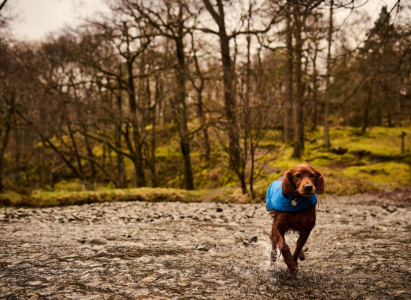Size & Weight
When purchasing a dog harness you will need measure your dog and look at the size guide provided to ensure you get the best fit. They shouldn't be too tight and you should be able to fit two fingers underneath the strap. It's also useful to know the weight of your dog to choose the right harness for your pet.
Types Of Dog Harnesses
There are many different designs of dog harnesses available, finding out which one is best suited to your dog is essential.
- A standard body harness will sit on your dogs chest and back therefore distributing the pressure evenly, they go over your dogs head and then usually clips together at the side. They then have loop where you can attach the lead.
- A Front-hook harness is similar to a body harness but the loop is at the front of the chest, these are often the best option if you do find your dog tends to pull on their lead.
- For a more flexible approach we would recommend a Dual Clip harness, this allows you to attach the lead to the front or the back.
- Step in harness is another great option, particularly for those dogs who aren't keen on having a harness put over their head. This harness just requires your dog to step into two loops and it then clips around the back.
Reflectivity
As mentioned above there are many different types of harness available but one feature you should look out for is it's reflective qualities. Many dog harnesses come with reflective detailing allowing your dog to be easily seen in the dark, making them ideal for keeping you and your furry friend safe during walkies in winter or evening walks when visibility is low.
Dog Harness vs Collar and Lead
However you decide on how to walk your dog they will always need a harness or collar. A dog collar and lead has been the traditional way to walk your pet as it’s a quick and easy way to control your pooch on days out, however a collar and lead can potentially injure your dog’s neck. When your dog pulls against their collar, they can easily injure themselves and choke making any outdoor adventure stressful on both you and your dog. Smaller short nosed breeds are also prone to breathing problems, so a quick pull on the collar can quickly turn into something serious. Some dog breeds can also effortlessly slip their lead leading to a chase around the local park, especially if you are puppy training. Whether you’re a new dog owner or aren’t sure which to use, it’s important to know the pros and cons for both dog harnesses and collars before making a decision.
What are the advantages of using a Dog Harness?
Dog harnesses discourage pulling when walking and also helps stop your pooch from jumping up at people whilst out on your daily walk. Dog harnesses also reduce the risk of neck injuries and respiratory problems for popular smaller brachycephalic breeds such as French Bulldogs and Pugs. Harnesses also provide better control over your dog which is important on busy pathways or in crowds, they also prevent your four legged friend getting tangled up in his or hers lead. A dog harness will give you much more control over a strong or larger dog also putting less stress on your own arms and back, making them ideal for older dog owners. Whatever your reason for choosing a dog harness, one of the best advantages owners consider a harness over a lead is that when out walking, your dog’s neck is not taking all the pressure and weight when pulling.
Practicality
When selecting which dog harness is best for you and your dog, it's important that you think practically.
- Will your dog cause any issues when you try to put a harness over their head?
- If you usually have a coat or jumper for your dog during the winter months that the harness will need to allow the room for this.
- Check to see how your harness should be cleaned.

